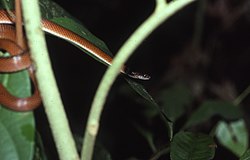Turtles (Testudines)
Trinidad has a total of 14 species of turtles that are grouped into 7 families. Among them, there are 5 marine species, almost all of them in danger of extinction. [2]
Tobago has a total of 7 species of turtle that are grouped into 4 families. [3]
Cheloniidae


Order: Testudines · Family: Cheloniidae
Sea turtles (Cheloniidae) are a family of large turtles found in all tropical seas and some subtropical and temperate seas. Sea turtles developed from land turtles about 120 million years ago and are well adapted to life in the sea. They feed mainly on jellyfish, crustaceans and squid. 4 chelonids were recorded in both Trinidad and Tobago.
- Caretta caretta (Linnaeus, 1758) EN
- Chelonia mydas (Linnaeus, 1758) EN
- Eretmochelys imbricata (Linnaeus, 1766) CR
- Lepidochelys olivacea (Eschscholtz, 1829) VU
Dermochelyidae

Order: Testudines · Family: Dermochelyidae
The leatherback sea turtle (Dermochelys coriacea) is the largest of all existing turtles and can reach a length of 2 metres (6.6 ft) and a weight of more than 600 kilograms (1,300 lb). It is found in all tropical or subtropical seas. Unlike most sea turtles, leatherbacks are often found in the colder waters of temperate zones. It is the only extant species of the Dermochelyidae family and is considered critically endangered. All other species in this family are only known as fossils. This species occurs in both Trinidad and Tobago.
- Dermochelys coriacea (Vandelli, 1761) CR
Chelidae

Order: Testudines · Family: Chelidae
- Chelus fimbriatus (Schneider, 1783)
- Mesoclemmys gibba (Schweigger, 1812)
Emydidae

Order: Testudines · Family: Emydidae
The emydidae (Emydidae) are a family of carnivorous aquatic and semi-aquatic turtles. They live most of the time in ponds, reservoirs and rivers, coming to land when they have to find suitable places to lay their eggs. This family is made up of 10 genera that contain more than 50 species. One of them occurs in Trinidad.
- Trachemys scripta (Thunberg in Schoepff, 1792)
Geoemydidae

Order: Testudines · Family: Geoemydidae
- Rhinoclemmys punctularia (Daudin, 1801)
Kinosternidae
Order Testudines · Family: Kinosternidae
- Kinosternon scorpioides (Linnaeus, 1766)
Podocnemididae

Order: Testudines · Family: Podocnemididae
- Podocnemis expansa (Schweigger, 1812)
- Podocnemis unifilis Troschel, 1848 VU
Testudinidae
Order: Testudines · Family: Testudinidae
- Chelonoidis carbonarius (Spix, 1824)
- Chelonoidis denticulatus (Linnaeus, 1766)















